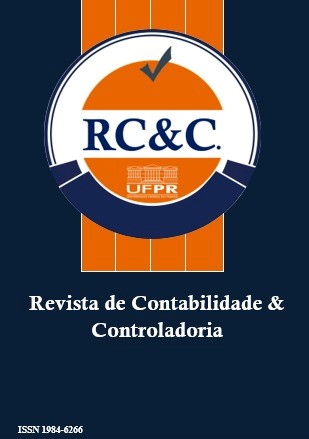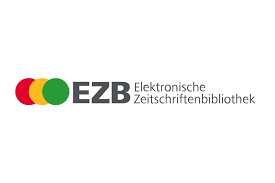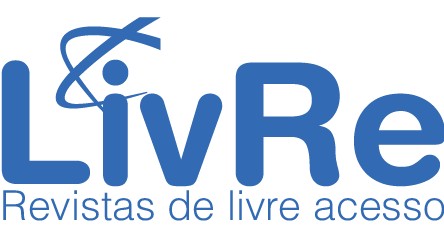Similaridade dos Principais Assuntos de Auditoria: uma análise por meio de Clusters
DOI:
https://doi.org/10.5380/rcc.v16i1.89537Palavras-chave:
Similaridade, Principais Assuntos de Auditoria, Análise de Cluster.Resumo
O objetivo deste estudo foi identificar, qual o índice de similaridade do título dos Principais Assuntos de Auditoria (PAA), e quais as características das firmas de auditoria e das companhias auditadas explicam essa similaridade. Espera-se preencher uma lacuna presente na literatura, ao tratar da similaridade na divulgação do PAA no relatório de auditoria. A partir de uma amostra de 1.370 observações de companhias listadas na B3, no período de 2016 a 2021, foram gerados agrupamentos em 2 clusters. Os resultados demonstraram que no período analisado houve uma similaridade média dos PAA de 73%, e que as companhias menores, menos rentáveis e que pagaram maiores honorários de auditoria possuíam maior similaridade dos PAA. Ademais, foi constatado que as companhias auditadas por firmas big four, que não possuíam opinião modificada no relatório de auditoria e que possuem comitê de auditoria constituído, apresentaram menor similaridade dos PAA. Constatou-se também que existe diferenças na similaridade dos PAA entre os setores econômicos das companhias. Este estudo contribui para o aprimoramento do processo de evidenciação contábil, ao permitir que os auditores independentes possam refletir sobre a similaridade na divulgação dos PAA e os impactos dessa padronização sobre os usuários da informação. Contribui também, para que os órgãos de regulamentação e fiscalização avaliem se os objetivos dos normativos que instituíram o novo relatório de auditoria contendo os PAA, estão sendo atingidos.
Referências
Alves, V., Sales Filho, M., da Silva, J., Gomes, H., & de Lima, D. (2022). A Semelhança do Conteúdo dos Principais Assuntos de Auditoria: Um Estudo nas Instituições Bancárias Listadas na B3. Revista de Contabilidade e Controladoria, 14(2). doi:http://dx.doi.org/10.5380/rcc.v14i2.83205
Alves Júnior, E. & Galdi, F. (2020). Relevância informacional dos principais assuntos de auditoria. Revista Contabilidade & Finanças, 31(82), 67-83. https://doi.org/10.1590/1808- 057x201908910
Asbahr, K. & Ruhnke, K. (2019). Real effects of reporting key audit matters on auditors’ judgment and choice of action. International Journal of Auditing. https://doi:10.1111/ijau.12154
Bédard, J. Gonthier-Besacier, N. & Schatt, A. (2014). Costs and benefits of reporting key audit matters in the audit report: The French experience. International Symposium on Audit Research. Recuperado de http://www.isarhq.org/2014_downloads/papers/ISAR2014_Bedard_Besacier_Schatt.pdf
Brasel, K., Doxey, M. M., Grenier, J. H., & Reffett, A. (2016). Risk disclosure preceding negative outcomes: the effects of reporting critical audit matters on judgments of auditor liability. The Accounting Review, 91(5), 1345–1362. https://doi:10.2308/accr-51380
Bortolon, P. M., Sarlo Neto, A., & Santos, T. B. (2013). Custos de auditoria e governança corporativa. Revista Contabilidade & Finanças, 24(61), 27-36. https://doi.org/10.1590/S1519-70772013000100004
Caliński, T. & Harabasz, J. (1974). A dendrite method for cluster analysis. Communications in Statistics, 3, 1-27. https://doi.org/10.1080/03610927408827101
Carvalho, O. A. de. (2021). Similaridade dos principais assuntos de auditoria em companhias abertas brasileiras. 107 f. Dissertação (mestrado) – Universidade Federal de Minas Gerais, Centro de Pós-Graduação e Pesquisas em Controladoria e Contabilidade.
Carson, E., Fargher, N. L., Geiger, M. A., Lennox, C. S., Raghunandan, K., & Willekens, M. (2013). Audit Reporting for Going-Concern Uncertainty: A Research Synthesis. AUDITING: A Journal of Practice & Theory, 32(Supplement 1), 353–384. https://doi:10.2308/ajpt-50324
Casterella, J. R., Francis, J. R., Lewis, B. L., & Walker, P. L. (2004). Auditor Industry Specialization, Client Bargaining Power, and Audit Pricing. AUDITING: A Journal of Practice & Theory, 23(1), 123–140. https://doi.org/10.2308/aud.2004.23.1.123
Comissão de Valores Mobiliários. (2018). Ofício-Circular CVM/ SNC/GNA Nº 01/18. Esclarecimentos relacionados à atuação do auditor no âmbito do mercado de valores mobiliários. http://www.cvm.gov.br/legislacao/oficios-circulares/snc/ocsnc-gna-01-2018.html
Conselho Federal de Contabilidade. (2016). Norma Brasileira de Contabilidade Técnica de Auditoria n. 701, de 17 de junho de 2016. Comunicação dos Principais Assuntos de Auditoria no Relatório do Auditor Independente. Recuperado de https://cfc.org.br/tecnica/normasbrasileiras-de-contabilidade/nbc-ta-de-auditoria-independente/
Conselho Federal de Contabilidade. (2016). Norma Brasileira de Contabilidade Técnica de Auditoria n. 200 (R1), de 05 de setembro de 2016. Objetivos Gerais do Auditor Independente e a Condução da Auditoria em Conformidade com Normas de Auditoria. Recuperado de https://cfc.org.br/tecnica/normasbrasileiras-de-contabilidade/nbc-ta-de-auditoria-independente/
Church, B. K., Davis, S. M. & Mccracken, S. A. (2008). The auditor's reporting model: a literature overview and research synthesis. Accounting Horizons, 22, 69-90.
Cruz, A., Nardi, P., Figueira, L., & Silva, R. (2019). A relação entre o novo relatório do auditor independente e o perfil das empresas auditadas e de auditoria. Revista Contemporânea de Contabilidade, 16(40), 3-23. https://doi.org/10.5007/2175-8069.2019v16n40p3
DeFond, M., & Zhang, J. (2014). A review of archival auditing research. Journal of Accounting and Economics, 58(2-3), 275–326. https://doi:10.1016/j.jacceco.2014.09.002
Doornik, J. A. & Hansen H. (2008). An omnibus test for univariate and multivariate normality. Oxford Bulletin of Economics and Statistics, 70, 927–939. https://doi.org/10.1111/j.1468-0084.2008.00537.x
Dopuch, N., Holthausen, R., & Leftwich, R. (1987). Predicting audit qualifications with financial and market variables. Accounting Review, LXII (3),431-454. Disponível em: https://www.jstor.org/stable/247571
Duda, R., Hart, P. & Stork, D. (2001). Pattern Classification. 2ª ed. John Willey.
Fávero, L. P. & Belfiore, P. (2017). Manual de Análise de Dados, 1ª edição. Rio de Janeiro. Editora Elsevier.
Ferreira, C., Morais, A. I. (2019). Análise da relação entre características das empresas e os key audit matters divulgados. Revista Contabilidade & Finanças, 31, 83, 262-274. https://doi.org/10.1590/1808-057x201909040
Gimbar, C., Hansen, B., & Ozlanski, M. E. (2016a). The effects of critical audit matter paragraphs and accounting standard precision on auditor liability. The Accounting Review, 91, 1629–1646. https://doi.10.2308/accr-51382.
Gold, A., Heilmann, M., Pott, C., & Rematzki, J. (2020). Do key audit matters impact financial reporting behavior? International Journal of Auditing, 24(2), 232-244. https://doi:10.1111/ijau.12190
Gujarati, D. N. (2006). Econometria Básica. 4ª edição. Rio de Janeiro. Editora Elsevier.
Gujarati, D. N., & Porter, D. C. (2011). Econometria Básica. (5ª ed.) Porto Alegre: AMGH.
Hsieh, S., Custodio, C. B., & Vasarhelyi, M. A. (2021). The textual similarity of KAM disclosures for spanish companies. The International Journal of Digital Accounting Research, 21, 183-202. https://doi:10.4192/1577-8517-v21_7
Huang, H., Liu, L., Raghunandan, K., & Rama, D. V. (2007). Auditor Industry Specialization, Client Bargaining Power, and Audit Fees: Further Evidence. AUDITING: A Journal of Practice & Theory, 26(1), 147–158. https://doi.org/10.2308/aud.2007.26.1.147
International Auditing and Assurance Standards Board. (2015).
International Standard on Auditing (ISA) 701 (NEW), Communicating Key Audit Matters in the Independent Auditor’s Report. IAASB. Recuperado de: https://www.ifac.org/ publications-resources/international-standard-auditing-isa701-new communicating-key-audit-matters
Khan, A., Muttakin, M. B., & Siddiqui, J. (2012). Corporate Governance and Corporate Social Responsibility Disclosures: Evidence from an Emerging Economy. Journal of Business Ethics, 114(2), 207–223. https://doi:10.1007/s10551-012-1336-0
Kend, M. & Nguyen, L. A. (2020). Investigating recent audit reform in the Australian context: An analysis of the KAM disclosures in audit reports 2017 at 2018. International Journal of Auditing, 24(3), 412–430. https://doi:10.1111/ijau.12205
Ketchen Junior, D. J. & Sook, C. L. (1996). The application of cluster analysis in strategic management research: an analysis and critique. Strategic Management Journal, 17, 441-458. https://doi.org/10.1002/(SICI)1097-0266(199606)17:6<441::AID-SMJ819>3.0.CO;2-G
Kettenring, J. R. (2006). The practice of cluster analysis. Journal of Classification, 23, 3-330. http://dx.doi.org/10.1007/s00357-006-0002-6
Lennox, C. S., Schmidt, J. J., & Thompson, A. (2017). Is the expanded model of audit reporting informative to investors? Evidence from the UK. SSRN Electronic Journal. https://doi:10.2139/ssrn.2619785
Lin, J., & Hwang, M. (2010). Audit quality, corporate governance, and earnings management: A meta‐analysis. International Journal of Auditing, 14(1), 57-77. https://doi:10.1111/j.1099-1123.2009.00403.x
Matos, T., Santos, O., Rodrigues, A., & Leite, R. (2018). Lobbying na regulação de auditoria no âmbito do IAASB. Revista Contabilidade & Finanças, 29(77), 246-265. https://doi.org/10.1590/1808-057x201804330
Mingoti, S. A. (2005). Análise de dados através de métodos de estatística multivariada: Uma abordagem aplicada. Belo Horizonte - Minas Gerais: Editora UFMG. 279 p.
Orquin, J., & Loose, S. (2013). A review on eye movements in decision-making. Acta Psychologica, 144(1), 190-206. http://dx.doi.org/10.1016/j.actpsy.2013.06.003
Pinto, I. & Morais, A. (2019). What matters in disclosures of key audit matters: Evidence from Europe. Journal of International Financial Management and Accounting, 30(2), 145-162. https://doi.org/10.1111/jifm.12095
Raupp, F. M., & Beuren, I. M. (2006). Como elaborar trabalhos monográficos em contabilidade: teoria e prática. (3ª ed.) São Paulo: Atlas.
Sierra-García, L., Gambetta, N., García-Benau, M. A., & Orta-Pérez, M. (2019). Understanding the determinants of the magnitude of entity-level risk and account-level risk key audit matters: The case of the United Kingdom. The British Accounting Review, 51, 227–240. https://doi:10.1016/j.bar.2019.02.004
Triola, M. F. (2005). Introdução à Estatística. (9ª ed.) Rio de Janeiro: LTC.
Velte, P. (2018). Does gender diversity in the audit committee influence key audit matters’ readability in the audit report? UK evidence. Corporate Social Responsibility and Environmental Management. https://doi:10.1002/csr.1491
Vinson, J. M., Robertson, J. C. & Cockrell, R. C. (2018). The effects of critical audit matter removal and duration on jurors’ assessments of auditor negligence. AUDITING: A Journal of Practice & Theory, 38(3), 183-202. https://doi.org/10.2308/ajpt-52319
Ward Junior, J. H. (1963). Hierarchical grouping to optimize an objective function Journal of the American Statistical Association, 58, 236-244. https://doi.org/10.1080/01621459.1963.10500845
Yang, L., Brink, A. G., & Wier, B. (2017). The impact of emotional intelligence on auditor judgment. International Journal of Auditing, 22(1), 83–97. https://doi.org/10.1111/ijau.12106
Downloads
Publicado
Como Citar
Edição
Seção
Licença
Copyright (c) 2024 RC&C. Revista de Contabilidade e Controladoria

Este trabalho está licenciado sob uma licença Creative Commons Attribution-NonCommercial-NoDerivatives 4.0 International License.
Os trabalhos publicados na RC&C. Revista de Contabilidade e Controladoria estão sujeitos aos seguintes termos:
1.1. A RC&C. Revista Contabilidade & Controladoria, através do Programa de Pós-Graduação em Contabilidade do Departamento de Contabilidade - Setor de Ciências Sociais Aplicadas - Universidade Federal do Paraná, retém os direitos de propriedade (direitos autorais) dos trabalhos publicados e incentiva e permite sua reutilização sob a Licença Creative Commons 4.0 de CC Attribution-NonCommercial-ShareAlike 4.0, para que possam ser copiados, utilizados, disseminados, transmitidos e exibidos publicamente, desde que:
1.1.a. A autoria e a fonte original da publicação (periódico, editora, URL e DOI do trabalho) sejam citadas.
1.1.b. Não sejam utilizados para fins comerciais ou onerosos.
1.1.c. A existência e as especificações desta licença de uso são mencionadas.
1.2. A publicação atribuirá a cada artigo um Identificador de Objeto Digital (DOI).









